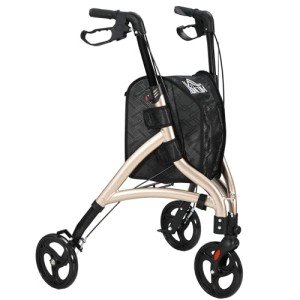
Rollator For Hiking
Add a review FollowOverview
-
Founded Date September 22, 1927
-
Posted Jobs 0
-
Viewed 18
Company Description
Responsible For The How To Use A Rollator Budget? 12 Tips On How To Spend Your Money

How To Use A Rollator: A Comprehensive Guide
Rollators are mobility aids designed to boost the self-reliance and safety of people with mobility obstacles. Unlike standard walkers, rollators are equipped with wheels, a seat, and frequently a storage pouch, enabling users to move with greater ease and convenience. This article provides an extensive guide on how to use a rollator efficiently and securely, ensuring a smoother and more satisfying walking experience.
What is a Rollator?
A rollator is a wheeled walking aid. It usually has:
- Three or 4 wheels: Offering stability and maneuverability.
- Hand brakes: For control while walking or when resting.
- A seat: Allowing users to take breaks easily.
- Storage space: Such as a basket or pouch for personal items.
Types of Rollators
There are numerous kinds of rollators, developed to fulfill the needs of different users:
| Type | Description | Best for |
|---|---|---|
| 3-Wheel Rollator | Lighter and more compact, perfect for indoor use | Browsing tight spaces |
| 4-Wheel Rollator | Deals stability and a bigger seat, suitable for outdoor use | Longer strolls and much heavier use |
| Durable Rollator | Created to support more weight with additional robust features | Users requiring additional assistance |
| Pediatric Rollator | Smaller sized in size, adjusted for children | Children with mobility limitations |
How to Use a Rollator
Utilizing a rollator properly is crucial to make sure safety and maximize the benefits it offers. Here’s a step-by-step guide:
Step 1: Adjust the Height
Before utilizing the rollator, it is necessary to change the handlebars to the appropriate height.
- Stand straight: With your arms relaxed at your sides.
- Procedure the height: The hand grips ought to be at wrist level when the user is standing.
- Safe and secure adjustments: Ensure all locking systems are strongly engaged.
Step 2: Familiarize Yourself with the Rollator
Understanding the parts of the rollator will assist improve its usability.
- Brakes: Learn how to engage and launch the brakes by squeezing the manages.
- Seat: Identify where to sit conveniently when you need to rest.
- Storage location: Know where you can store individual valuables.
Action 3: Start Walking
- Position the rollator: Place it an action ahead of you, guaranteeing that the brakes are launched.
- Grip the deals with firmly: Keep a light stress in your arms while holding onto the rollator.
- Step inside the frame: Move forward by stepping with one foot and after that the other.
- Maintain a straight posture: Walking need to be upright, preventing the temptation to lean on the rollator excessively.
Step 4: Utilize Brakes
Always use the brakes successfully to improve safety:
- To slow down: Gradually squeeze the brakes.
- To stop: Fully engage the brakes by pulling on both handles.
- To take a seat: Ensure the rollator is stable, then thoroughly lower yourself onto the seat.
Step 5: Maneuver with Care
Turning and browsing can be difficult, so here are vital tips:
- Telegraph your direction: Look where you wish to precede turning.
- Take small steps: Move gently when turning to preserve balance.
- Use a three-point turn: Turn from one side to the other, keeping the walker close.
Action 6: Practice Stopping and Resting
Taking breaks is vital. Here are pointers for resting:
- Find flat surface areas: Ensure the area is level when you sit.
- Engage the brakes when seated: This will prevent rolling.
- Shift position gradually: When all set to stand again, get rid of the brakes before increasing.
Upkeep and Safety Tips
To ensure the rollator remains functional and safe:
- Regularly inspect the brakes: Ensure they engage and launch properly.
- Check wheel alignment: Wheels ought to not wobble; tighten any loose screws.
- Clean the rollator: Wipe down surfaces and eliminate debris from tires to preserve smooth operation.
Common Concerns
Users might face a number of common concerns when utilizing rollators. Here are some basic FAQs:
FAQs
Q1: Can I use a rollator outdoors?A: Yes, a lot of
rollators are designed for both indoor and outdoor use. Nevertheless, guarantee it has the proper wheel size and tread for outdoor surfaces. Q2: What are the weight limits on rollators?A: Weight restricts
generally vary by design, however sturdy rollators can normally accommodate users weighing around 300 to 500 pounds. Q3: Are rollators adjustable?A: Yes, a lot of rollators feature adjustable handle heights to accommodate users of numerous heights
. Q4: How do I carry a rollator?A: Many rollators canbe folded for hassle-free transportation in a vehicle. Always check the user manual for specific folding guidelines. Q5: Can I use a rollator while recuperating from surgery?A: Yes, numerous individuals use rollators throughout recovery to restore strength and balance, but ensure you follow your doctor’s recommendations.
Comprehending how to use a rollator correctly can substantially enhance Mobility aid and minimize the threat of falls. Whether you are new to using mobility aids or seeking to refine your technique, following the standards gone over in this post is vital. With practice, a rollator can boost self-reliance while making sure safety, hence enabling users to enjoy a more active lifestyle.
